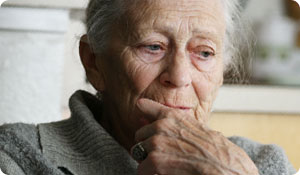
Of the 35 million Americans 65 and older, roughly seven million suffer from either major depression or a less severe form of depression. Although depression is highly treatable, many older adults--especially those living in senior facilities--are never diagnosed. Subsequently, the rate of suicide in this population is high. In fact, adults 65 and older account for more than 14 percent of all suicides, and the rate is highest among white men over 85. Women are more likely to commit suicide by suffocation and poisoning (including overdosing) while men typically use firearms.
The American Foundation for Suicide Prevention says seniors present fewer warnings of intent to commit suicide. They carefully plan their deaths, determined to be successful, and are more likely not to survive suicide attempts because of the methods they employ.
Depression and other psychiatric disorders pose the greatest risk factor for suicide. Seniors often feel socially isolated and many are in pain due to other illnesses, which can bring about or exacerbate depression. Sadly, up to 75 percent of seniors who commit suicide visit their primary care physician within a month of their death. Physicians do not routinely screen for depression and miss the opportunity to provide preventative mental health support.
Residents in senior living facilities typically share similar social status, life experiences, and functional abilities. While the tendency to identify with others can be positive, it can also extend to peers' misfortune, enhancing feelings of vulnerability. Moving to a senior living facility usually coincides with a major life event, such as loss of a spouse or ability to live independently, causing feelings of anxiety, confusion, fear, helplessness, and loneliness, which can all trigger or worsen depression.
What to Do
If you are concerned about depression in a loved one who lives in a senior facility, here are a few suicide prevention tips.
- Recognize warning signs of depression, including nervousness; feeling emotionally empty, guilty, or worthless; sleep problems; persistent aches; loss of interest in activities; and frequent crying.
- Encourage the person to seek professional help. Antidepressants and psychotherapy are extremely effective for treating depression.
- Be caring, helpful, and supportive. Listen without judgment and don't promise confidentiality.
- Ask if they are considering suicide. Asking someone about suicide won't make him or her suicidal and, in fact, simply asking may actually prevent a suicide. If you believe the person's intent to commit suicide is imminent, call 911.
- Invite seniors out and help them schedule social activities to limit isolation and loneliness.
- Plan and prepare healthy meals for them.
Sources
Podgorski C.A., Langford L., Pearson J.L., Conwell Y. (2010). "Suicide Prevention for Older Adults in Residential Communities: Implications for Policy and Practice." PLoS Med 7(5): e1000254. Web. 18 May 2010. http://www.plosmedicine.org/article/info:doi%2F10.1371%2Fjournal.pmed.1000254
National Institutes of Heath. "Senior Health, Depression." Web. 8 January 2008.
http://nihseniorhealth.gov/siteindex.html
National Institutes of Health. "How do older adults experience depression?" Web. 30 January 2009.
Clayton, Paula, M.D. "Suicide and the Elderly." American Foundation for Suicide Prevention. Powerpoint. Web. http://www.afsp.org/index.cfm?fuseaction=home.viewPage&page_id=598DA610-DC4C-A681-45A4701729BA0C93





